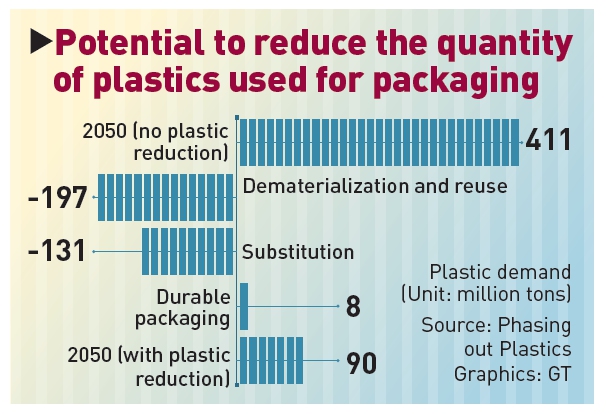Wood, metal, paper and fabric can help cut climate-harming emissions
Report urges phasing out of plastics
Replacing plastics used in buildings with metal, wood, ceramics and glass, turning to paper and fabric for packaging, and boosting recycling rates could slash planet-warming greenhouse gas emissions by 2050, researchers said on Monday.
A mixture of substitution, changes in business models and consumer behavior, and producing more plastics without using fossil fuels could halve global plastic consumption and cut emissions from plastics by more than half, they said.

"Although plastics permeate our lives and every corner of our planet, it is technically possible to largely phase them out," the report said.
Lead researcher Andrew Scott told Reuters that all but 1-2 percent of plastics are made from fossil fuels, principally oil and gas, with the emissions produced at different stages of the value chain.
"When somebody buys a plastic product, they don't actually generate emissions when they're using it. But there's emissions embodied in the product from the previous stages," he said, adding that emissions could also come from discarded plastics.
The largest use of plastics is for packaging, accounting for 36 percent of total output in 2015, followed by construction at 16 percent, the report said.
However, switching to nonplastic alternatives that are currently available, such as wood and metal, could reduce the use of plastics in the construction industry by 95 percent, it said.
A combination of regulation on single-use plastics and changes in consumer behavior could cut plastic consumption by 78 percent in the packaging sector, it added.
There is also much room for improvement with recycling as only about 20 percent of plastic waste is recycled today, the report noted.
It also looked at the automotive and electrical and electronic equipment sectors, which together with construction and packaging make up more than 60 percent of plastic use, said Scott.
North America, Europe and East Asia consume almost two-thirds of the world's plastics, the report said.
A mixture of substitution, changes in business models and consumer behavior, and producing more plastics without using fossil fuels could halve global plastic consumption and cut emissions from plastics by more than half, they said.

"Although plastics permeate our lives and every corner of our planet, it is technically possible to largely phase them out," the report said.
Lead researcher Andrew Scott told Reuters that all but 1-2 percent of plastics are made from fossil fuels, principally oil and gas, with the emissions produced at different stages of the value chain.
"When somebody buys a plastic product, they don't actually generate emissions when they're using it. But there's emissions embodied in the product from the previous stages," he said, adding that emissions could also come from discarded plastics.
The largest use of plastics is for packaging, accounting for 36 percent of total output in 2015, followed by construction at 16 percent, the report said.
However, switching to nonplastic alternatives that are currently available, such as wood and metal, could reduce the use of plastics in the construction industry by 95 percent, it said.
A combination of regulation on single-use plastics and changes in consumer behavior could cut plastic consumption by 78 percent in the packaging sector, it added.
There is also much room for improvement with recycling as only about 20 percent of plastic waste is recycled today, the report noted.
It also looked at the automotive and electrical and electronic equipment sectors, which together with construction and packaging make up more than 60 percent of plastic use, said Scott.
North America, Europe and East Asia consume almost two-thirds of the world's plastics, the report said.
